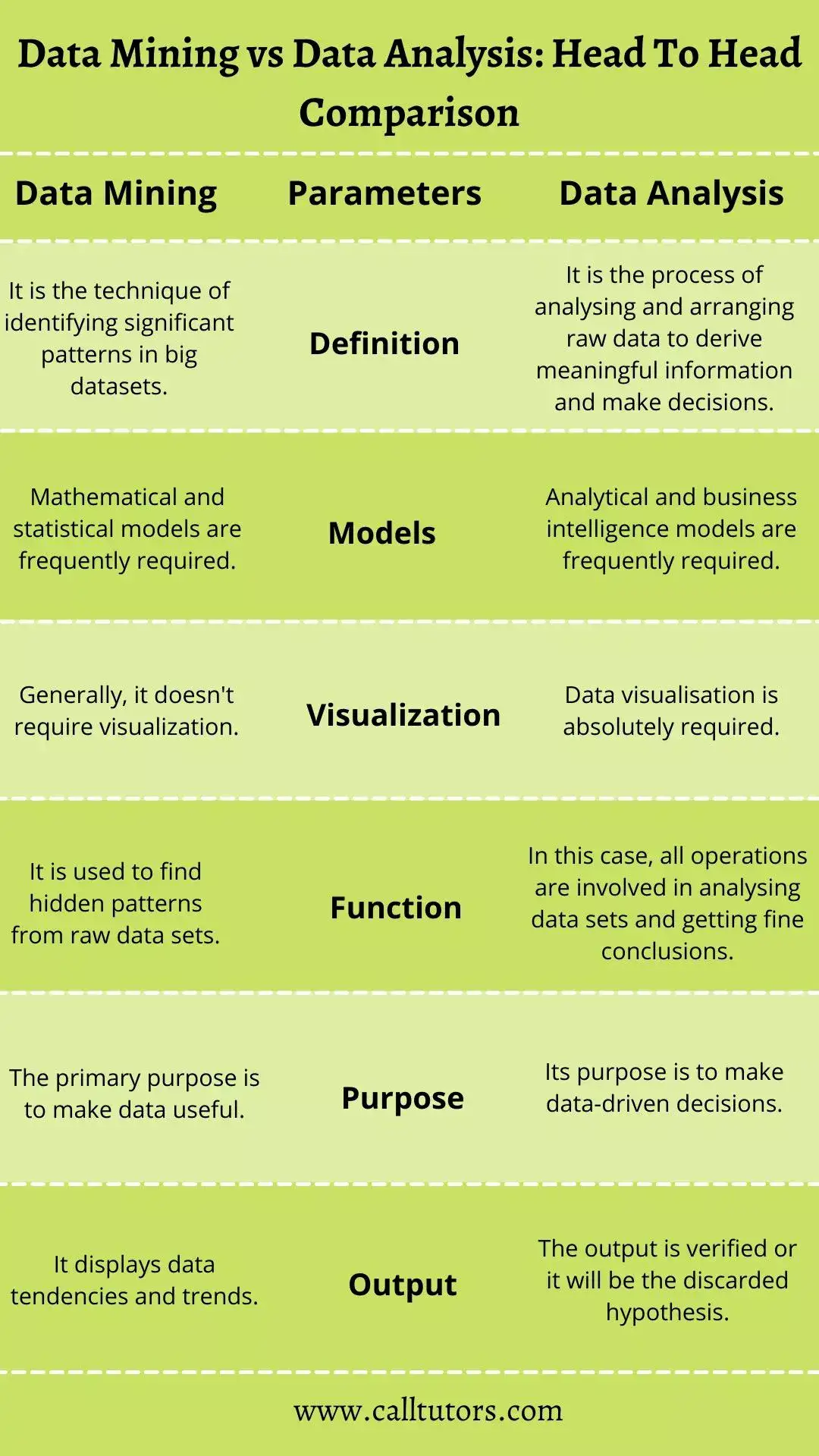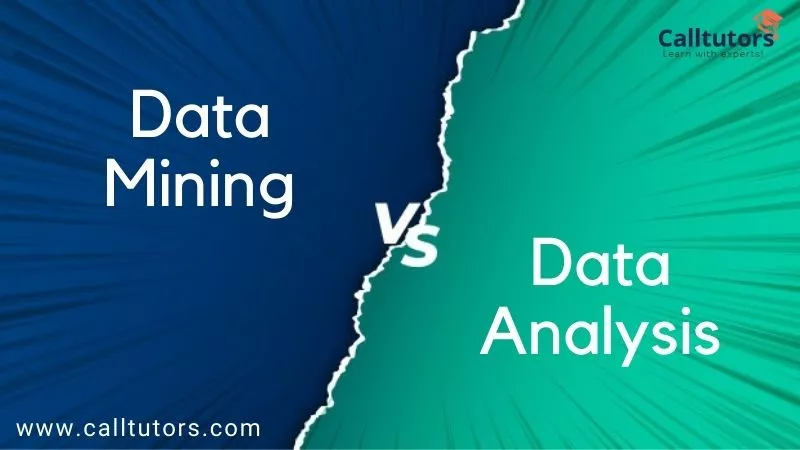Are you interested in knowing about some key differences between Data Mining vs Data Analysis? If yes, then you are at the right place. Data Mining vs Data Analysis is always a big concern among the students. Before going deeper, Let’s start with a short introduction to each of these terms.
Introduction To Data Mining
Table of Contents
Data mining is a method that converts raw data into meaningful data. It assists organizations in developing more innovative strategies, increasing sales, generating revenue, and growing a business through cost reduction. Because data mining is based on research, many companies employ it to turn data into meaningful information.
Introduction To Data Analysis
Data analysis is a process for investigating, analysing, and demonstrating data in order to discover relevant information. There are numerous forms of that, but most people focus on quantitative data initially. For example, census data comes after surveying.
Data Mining vs Data Analysis: Techniques
Have a look at some techniques of both Data mining and Data analysis:
| Data Mining | Data Analysis |
Data Mining vs Data Analysis: The Key Differences
Although data mining and data analysis are separate terms and processes, some individuals use them interchangeably. This is also dependent on the organisation or project team performing such tasks where this distinction is not explicitly marked. To establish their separate identity, we will highlight the following key differences:
- Data analysis provides insights or evaluates hypotheses or models based on data. In this stage, companies can leverage Google Sheets alternatives to efficiently organize and analyze their data, thereby enhancing their data mining and analysis processes.
- One of the activities in Data Analysis is data mining. Data analysis is a comprehensive set of activities that involves the collection, preparation, and modelling of data in order to extract meaningful insights or knowledge. Sometimes, both are included as Business Intelligence subsets.
- The majority of data mining research focuses on structured data, and also, on both structured, semi-structured, and unstructured data, the data analysis can be done.
- Data Mining’s goal is to make data more usable, whereas Data Analysis aids in proving a hypothesis or making business decisions.
- There is no requirement for a preexisting theory in data mining to detect a pattern or trend in data. In contrast, data analysis tests a particular theory.
- Data mining utilises mathematical and scientific approaches to detect patterns or trends, whereas data analysis employs business intelligence and analytics models.
- Although data mining does not often include the use of a visualisation tool, data analysis is usually accompanied by the visualisation of outcomes.
Data Mining vs Data Analysis: Head To Head Comparison

Data Mining vs Data Analysis: In Tabular Form
| Basis For Comparision | Data Mining | Data Analysis |
| Definition | It is the technique of identifying significant patterns in big datasets. | It is the process of analysing and arranging raw data to derive meaningful information and make decisions. |
| Models | Mathematical and statistical models are frequently required. | Analytical and business intelligence models are frequently required. |
| Required Knowledge | It usually requires knowledge of machine learning, statistics, and databases. | It usually requires knowledge of computer science, statistics, mathematics, and Al/Machine Learning. |
| Function | It is used to find hidden patterns from raw data sets. | In this case, all operations are involved in analysing data sets and getting fine conclusions. |
| Visualization | Generally, it doesn’t require visualization. | Data visualisation is absolutely required. |
| Also known as | It is also known as Knowledge discovery in databases. | Descriptive statistics, exploratory data analysis, and confirmatory data analysis are the kinds of data analysis. |
| Data set | This data set is often vast and well-structured. | The size of the data collection might be huge, medium, or a small one. Also, it can be, Structured, semi-structured, or unstructured. |
| Purpose | The primary purpose is to make data useful. | Its purpose is to make data-driven decisions. |
| Output | It displays data tendencies and trends. | The output is verified or it will be the discarded hypothesis. |
Data Mining vs Data Analysis: Tools
Have a look at some tools of both Data mining and Data analysis:
| Data Mining | Data Analysis |

Data Mining vs Data Analysis: Career Opportunities
Have a look at some career opportunities of both Data mining and Data analysis:
| Data Mining | Data Analysis |
Data Mining vs Data Analysis: Skills Requirement
Have a look at some skills requirements of both Data mining and Data analysis:
Skills Requirement In Data Mining
The skills that are required in Data mining are the following:
- Hands-on expertise with operating systems such as Linux, Windows, and others.
- Machine learning Programming languages like Python programming and JavaScript are two examples of programming languages.
- Expertise in data analysis tools like NoSQL and SAS.
- Familiar with industry trends
- Public Speaking Capabilities
- Expertise in statistics
- Understanding of data structures and algorithms
- Proficiency in business intelligence
- Natural language processing and deep learning
In addition to these abilities, the data mining specialist should have interpersonal, problem-solving, and decision-making abilities.
Skills Requirement In Data Analysis
The skills that are required in Data analysis are the following:
- Strong knowledge and understanding of industry trends.
- Mathematical expertise is required for numerical data processing.
- NoSQL and SAS are examples of data analysis tools.
- Extensive knowledge of machine learning concepts.
- Critical thinking and problem-solving abilities are required.
- Data visualisation abilities
- Excellent mastery of MS Excel Presentation Skills
- Deep knowledge of programming languages like R or Python
- Great communication abilities
Apart from these skills, the data analyst should work with the team.
Conclusion: Data Mining vs Data Analysis
In this blog, we have discussed Data Mining vs Data Analysis. And after comparing it’s clear that both Data Mining vs Data Analysis are good ones to learn for students. And, for the students to understand the essential differences between the terms Data Mining vs Data Analysis is very helpful. But if in any case, you need assistance regarding Data Mining Assignment Help then feel free to contact us. We are always available to help you.
FAQs Related To Data Mining vs Data Analysis
Is data mining related to data analytics?
Data mining is a vital part of data analytics and one of the major disciplines in data science that use advanced analytical techniques to discover meaningful information in data sets.
What are the types of data mining?
The types of data mining are the following which are shown below:
1. Pictorial data mining
2. Text mining
3. Social media mining
4. Web mining
5. Audio and Video mining



